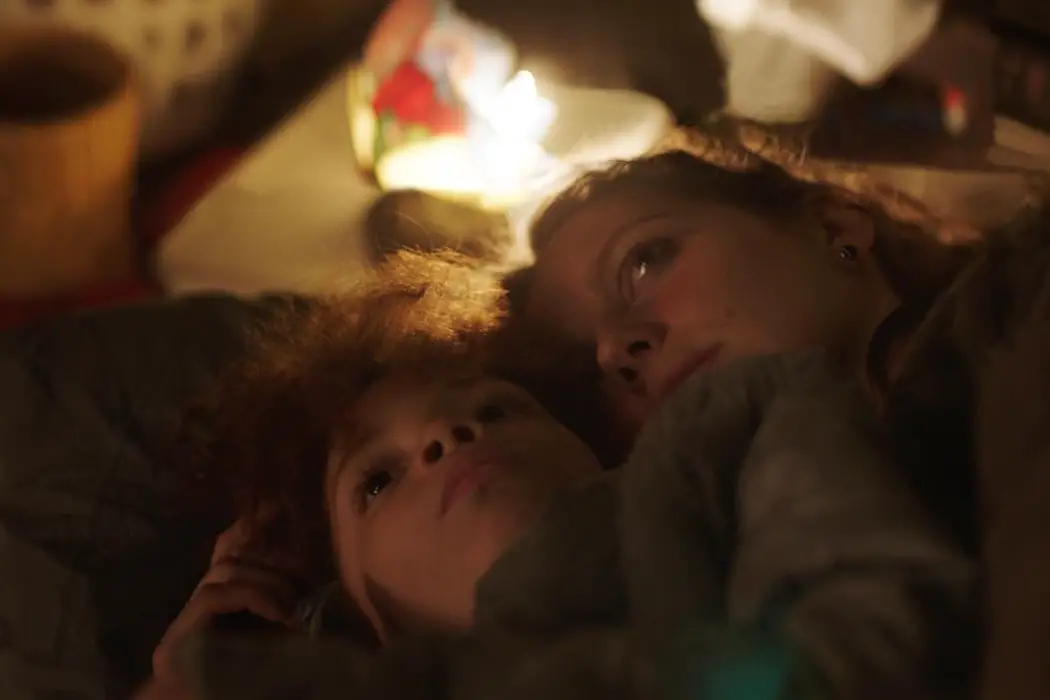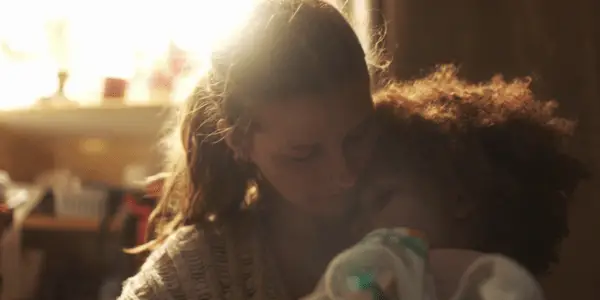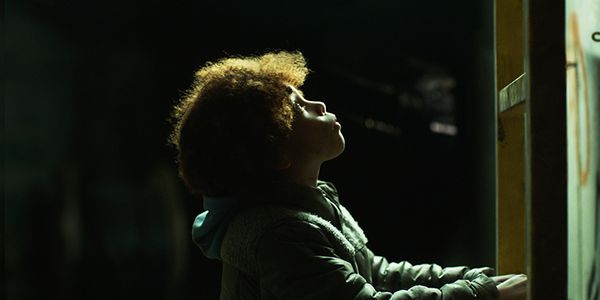TOPSIDE: The Unforgiving Surface

Soham Gadre is a writer/filmmaker in the Washington D.C. area.…
Warning: this review has SPOILERS
There were two films nominated for Best Picture at the Oscars this year – Belfast and Coda – that aimed to position children coming out of their innocence amid familial difficulty, through identity, and in a changing economic climate. Celine Held and Logan George’s debut feature Topside does all of those things better than both Oscar-contenders. It’s a movie that combines its aching childlike innocence, slowly being stripped away to the raw bone, with an unforgiving environment made and populated by negligent adults. It maintains its child actress’s ever hopeful eye as a light in a dark tunnel amid the devastation and a final sequence that teeters on the brink of emotional exploitation.
Innocence in Chaos
We center on a mother and child living underground near abandoned subway lines – not a fictional premise at all, New York City’s subway communities have been the subject of many essays and even documentaries like Marc Singer’s Dark Days. Their names are Nikki (Celine Held) and Little (Zhaila Farmer) respectively. Holed up in a makeshift shack in the depths of the subway system, their only sources of light are the tunnel lamps, some Christmas bulbs they hang up on the walls, and occasionally the flashlights of service workers who come to try to offer to take them to a homeless shelter. One of these visits by the service workers is less friendly than previous ones. They inform Nikki and Little that their resident subway tunnel is being renovated and they have to be taken away. Thus begins the journey to what Little refers to as “Topside” (the above ground).

Two striking moments in the movie, both hard to shake, take place in situations where Nikki and Little are separated. First, when Nikki leaves Little in the living room of her dealer/pimp Les’s (Jared Abrahamson) apartment, Little catches in her eyes the bright lights faintly glimmering outside of the window. The camera takes her perspective as it inches closer to the window. The lights are blurry and ambiguous at first – reminiscent of the distant flashlights she used to see in the tunnels, but as she gets closer, the skyline appears. She thinks they’re stars. The stillness in this sequence is a perfect respite from the roller-coaster that this film embodies for most of its runtime. Even amid the fear, danger, and murk of Little’s existence, her innocence still shines – in a world of adults who have failed her at every turn, she finds beauty and something to be amazed by.
Hollywood has a strange tendency to treat child-centric films like they’re supposed to be for children. Too many times the reasoning becomes because the world is being visually seen from the perspective of a child, it should also embody the narrative perspective of one. This is where Topside sets itself apart from fluff like Coda and Belfast. Held and George’s movie deftly shifts the perspective between Nikki and Little, allowing us to experience the city’s unforgiving environment and the destabilization in two walks of life. Its camerawork balances the wandering eyes of a young, confused child in strange surroundings with that of a teetering adult who is trying to place broken pieces of their lives back together. The result is as affecting as it is cataclysmic.
An Uneasy Ending
If there’s a flaw in this film, it comes in the final moments of separation between Nikki and Little. While Nikki is high, she loses track of her daughter on the platform and leaves her there only to realize after the doors close on the subway train. It’s an explosively emotional moment and Celine Held’s performance reaches peak anguish here – vomiting, crying, in a complete tornado whirl of self-hatred. This is where the movie’s drug-fueled bad parenting plot-line veers into a territory of cloying tragedy-porn. Little’s final moments in the film are her watching a bird on the platform using its wings to fly away (wings and metamorphosis are motifs from early on), which symbolically signals Little’s separation from her mother. However, we never get her perspective again. The film instead still gives Nikki the validation of having the choice to ultimately leave Little “for her sake” because she does inexplicably find her again.

She tells the conductor that there’s an abandoned child on the train and the police come to get her. The music swells and Nikki walks away in tears while the “nice” police officer tries to get Little to come out from underneath the subway seat. Throughout the movie, men tell Nikki that what’s best for her child is to hand her over to the system, to child protective services, or anyone in authority, and she rejects it at every turn. She gets paranoid whenever anyone picks up a phone – at the church, at the train station – for fear that they’ll be separated. In this light, Topside’s ending is a curious and inadequate conclusion if not unprincipled. There’s no social or political reason for why this ending should or could be cathartic, but it is made to feel that way because of everything that precedes it.
Conclusion
Despite that, Topside makes its points enough beforehand to deliver a disorienting and visually challenging portrayal of abandonment and desperation in New York City. In a place where poverty and development are at complete odds with each other, where infrastructure and humanity run in opposite directions, where the stars are on billboards instead of in the sky, where buildings keep getting taller and the value of people keeps getting buried underneath the ground, into the dark tunnels, the city in Topside is unforgiving. Yet, for maybe a brief moment, glimpses of beauty emerge in the chaos.
Have you seen Topside? What did you think? Let us know in the comments below!
Topside was released on March 25th in Select Theaters and Video-On-Demand.
Watch Topside
Does content like this matter to you?
Become a Member and support film journalism. Unlock access to all of Film Inquiry`s great articles. Join a community of like-minded readers who are passionate about cinema - get access to our private members Network, give back to independent filmmakers, and more.
Soham Gadre is a writer/filmmaker in the Washington D.C. area. He has written for Hyperallergic, MUBI Notebook, Popula, Vague Visages, and Bustle among others. He also works full-time for an environmental non-profit and is a screener for the Environmental Film Festival. Outside of film, he is a Chicago Bulls fan and frequenter of gastropubs.












